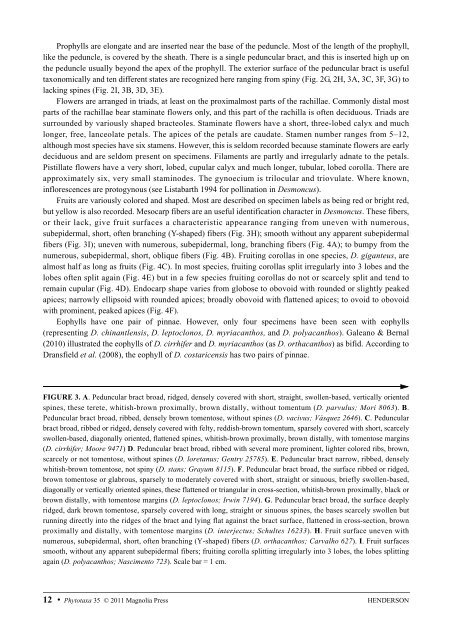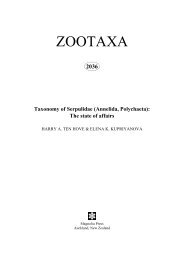You also want an ePaper? Increase the reach of your titles
YUMPU automatically turns print PDFs into web optimized ePapers that Google loves.
Prophylls are elongate and are inserted near the base of the peduncle. Most of the length of the prophyll,<br />
like the peduncle, is covered by the sheath. There is a single peduncular bract, and this is inserted high up on<br />
the peduncle usually beyond the apex of the prophyll. The exterior surface of the peduncular bract is useful<br />
taxonomically and ten different states are recognized here ranging from spiny (Fig. 2G, 2H, 3A, 3C, 3F, 3G) to<br />
lacking spines (Fig. 2I, 3B, 3D, 3E).<br />
Flowers are arranged in triads, at least on the proximalmost parts of the rachillae. Commonly distal most<br />
parts of the rachillae bear staminate flowers only, and this part of the rachilla is often deciduous. Triads are<br />
surrounded by variously shaped bracteoles. Staminate flowers have a short, three-lobed calyx and much<br />
longer, free, lanceolate petals. The apices of the petals are caudate. Stamen number ranges from 5–12,<br />
although most species have six stamens. However, this is seldom recorded because staminate flowers are early<br />
deciduous and are seldom present on specimens. Filaments are partly and irregularly adnate to the petals.<br />
Pistillate flowers have a very short, lobed, cupular calyx and much longer, tubular, lobed corolla. There are<br />
approximately six, very small staminodes. The gynoecium is trilocular and triovulate. Where known,<br />
inflorescences are protogynous (see Listabarth 1994 for pollination in Desmoncus).<br />
Fruits are variously colored and shaped. Most are described on specimen labels as being red or bright red,<br />
but yellow is also recorded. Mesocarp fibers are an useful identification character in Desmoncus. These fibers,<br />
or their lack, give fruit surfaces a characteristic appearance ranging from uneven with numerous,<br />
subepidermal, short, often branching (Y-shaped) fibers (Fig. 3H); smooth without any apparent subepidermal<br />
fibers (Fig. 3I); uneven with numerous, subepidermal, long, branching fibers (Fig. 4A); to bumpy from the<br />
numerous, subepidermal, short, oblique fibers (Fig. 4B). Fruiting corollas in one species, D. giganteus, are<br />
almost half as long as fruits (Fig. 4C). In most species, fruiting corollas split irregularly into 3 lobes and the<br />
lobes often split again (Fig. 4E) but in a few species fruiting corollas do not or scarcely split and tend to<br />
remain cupular (Fig. 4D). Endocarp shape varies from globose to obovoid with rounded or slightly peaked<br />
apices; narrowly ellipsoid with rounded apices; broadly obovoid with flattened apices; to ovoid to obovoid<br />
with prominent, peaked apices (Fig. 4F).<br />
Eophylls have one pair of pinnae. However, only four specimens have been seen with eophylls<br />
(representing D. chinantlensis, D. leptoclonos, D. myriacanthos, and D. polyacanthos). Galeano & Bernal<br />
(2010) illustrated the eophylls of D. cirrhifer and D. myriacanthos (as D. orthacanthos) as bifid. According to<br />
Dransfield et al. (2008), the eophyll of D. costaricensis has two pairs of pinnae.<br />
FIGURE 3. A. Peduncular bract broad, ridged, densely covered with short, straight, swollen-based, vertically oriented<br />
spines, these terete, whitish-brown proximally, brown distally, without tomentum (D. parvulus; Mori 8063). B.<br />
Peduncular bract broad, ribbed, densely brown tomentose, without spines (D. vacivus; Vásquez 2646). C. Peduncular<br />
bract broad, ribbed or ridged, densely covered with felty, reddish-brown tomentum, sparsely covered with short, scarcely<br />
swollen-based, diagonally oriented, flattened spines, whitish-brown proximally, brown distally, with tomentose margins<br />
(D. cirrhifer; Moore 9471) D. Peduncular bract broad, ribbed with several more prominent, lighter colored ribs, brown,<br />
scarcely or not tomentose, without spines (D. loretanus; Gentry 25785). E. Peduncular bract narrow, ribbed, densely<br />
whitish-brown tomentose, not spiny (D. stans; Grayum 8115). F. Peduncular bract broad, the surface ribbed or ridged,<br />
brown tomentose or glabrous, sparsely to moderately covered with short, straight or sinuous, briefly swollen-based,<br />
diagonally or vertically oriented spines, these flattened or triangular in cross-section, whitish-brown proximally, black or<br />
brown distally, with tomentose margins (D. leptoclonos; Irwin 7194). G. Peduncular bract broad, the surface deeply<br />
ridged, dark brown tomentose, sparsely covered with long, straight or sinuous spines, the bases scarcely swollen but<br />
running directly into the ridges of the bract and lying flat against the bract surface, flattened in cross-section, brown<br />
proximally and distally, with tomentose margins (D. interjectus; Schultes 16233). H. Fruit surface uneven with<br />
numerous, subepidermal, short, often branching (Y-shaped) fibers (D. orthacanthos; Carvalho 627). I. Fruit surfaces<br />
smooth, without any apparent subepidermal fibers; fruiting corolla splitting irregularly into 3 lobes, the lobes splitting<br />
again (D. polyacanthos; Nascimento 723). Scale bar = 1 cm.<br />
12 Phytotaxa 35 © 2011 <strong>Magnolia</strong> <strong>Press</strong><br />
HENDERSON
















